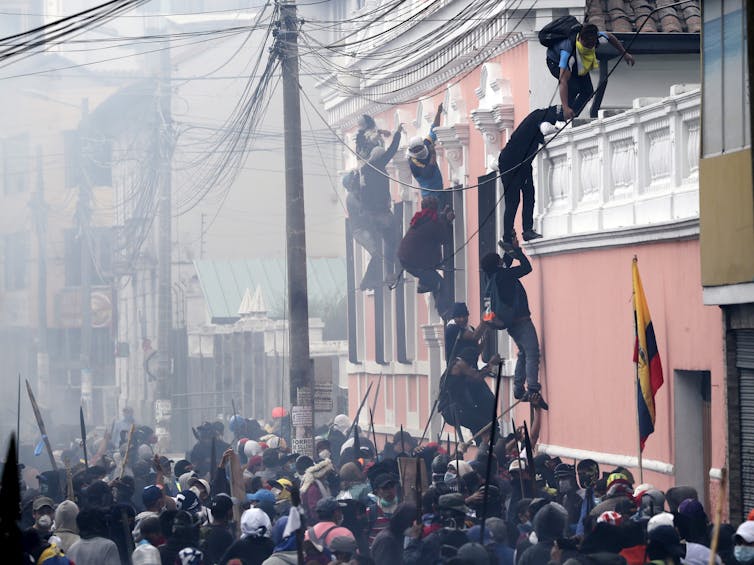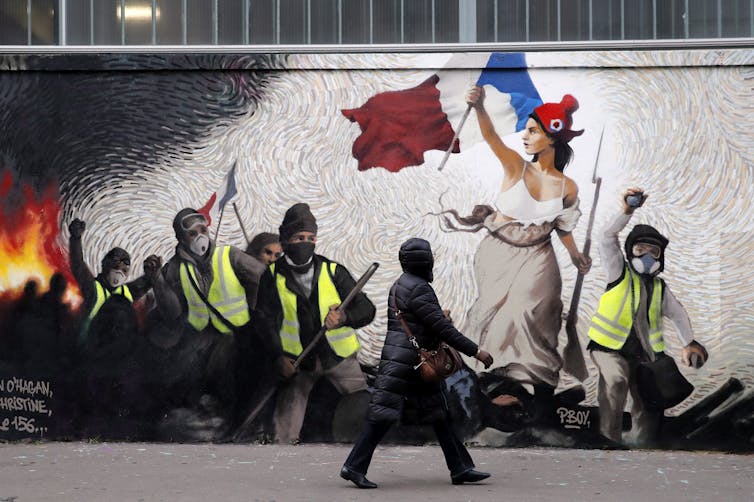Katherine Monahan, University of Ottawa
In early October, the city centre near the House of Ecuadorian Culture in Quito, Ecuador, hummed with the sounds of uniformed school children, foreign tourists, civil servants and commuters. Some stopped to relax or eat in the groomed parks nearby.
Within the week, the area was engulfed in violent chaos. Police fired tear gas into crowds of angry marchers that had taken over the culture museum. “It just keeps getting worse and worse,” said Maria Fernanda Sanchez, a Quito resident and bystander to the protests.
The protests started on Oct. 2 in response to the federal government’s “Decreto 883,” a packet of economic adjustments that eliminated a government fuel subsidy worth close to US$1.4 billion per year. The package was designed to help meet the US$4.2 billion loan requirements from the International Monetary Fund (IMF), but resulted in civil unrest as energy prices rose across the country.
This recent upheaval in Ecuador has important lessons for Canadian climate change policy. The mass protests shine a spotlight on the tension that can arise between policies that raise energy prices and day-to-day energy affordability.
The Ecuadorian experience
Ecuador’s removal of the 40-year-old fuel subsidy saw gas and diesel prices rise sharply. The price of gasoline rose to $0.80 per litre (US$2.30/gallon) from $0.64 per litre (US$1.85/gallon) and the cost of diesel more than doubled.

A violent storm of protests followed, led by lower-income earners, including Indigenous, student and labour unions. After 11 days of unrest and hundreds of millions of dollars in economic damages, Ecuadorian President Lenín Moreno backed down and reversed the policy.
Moreno’s backtrack highlight the risks that come when fossil fuel subsidy reform (or broader fiscal climate policy) is implemented in a difficult political, social, and economic context. Fossil fuel subsidy reforms save governments money, but they are also a key ingredient to tackling climate change.
Fossil fuel subsidies and climate change
Fossil fuel subsidies artificially lower prices on oil, gasoline and other petroleum products for consumers and producers to below market levels, and encourage their use over climate-friendly alternatives.
The International Energy Agency (IEA) estimates that global subsidies to consumers alone were US$400 billion in 2018, and this does not include subsidies to oil and gas producers where poor transparency clouds estimates. Together, the G20 subsidizes the production and consumption of coal, oil and gas by at least US$150 billion annually.
The UN Secretary General António Guterres, the IEA and others emphasise that fossil fuel subsides are hindering efforts to reduce global greenhouse gas emissions. “The continued prevalence of [global fossil fuel] subsidies — more than double the estimated subsidies to renewables — greatly complicates the task,” the IEA reported in June.
Canada has already made significant strides in using fiscal policy such as carbon pricing to tackle climate change, but additional monetary and regulatory policies are needed to hit the 2030 Paris target and the 2050 net-zero pledge.
And Canada and the provinces continue to support fossil fuels with billions of dollars domestically. Canada, along with its G20 peers, has reaffirmed its commitment to remove any “inefficient” federal fossil fuel subsidies every year since 2009. Canada went one step further and committed to a 2025 deadline. As part of Canada’s commitment, the federal government is currently identifying inefficient programs with a view to reforms.
Lessons from Ecuador
Fossil fuel subsidy reform, carbon pricing and regulations, can all lead to a period of economic adjustment that sees prices rise — at least in the short-term — while technology and innovation catch up.
Ecuador’s response is not unique. France saw the escalation of the yellow vest movement in 2018 after President Emmanuel Macron and his government increased a carbon tax that raised fuel prices.
Moreno’s reforms were not directly linked to environmental policy — the IMF loan agreement and desire to stop smuggling of fuel to neighbouring countries were the principle motivations. Yet they offer sharp lessons in what could go wrong when subsidy reform and fiscal policy is poorly implemented.
Too fast, too furious
Ecuador raised its fuel prices too quickly. Gradual, predictable, incremental roll-out is nearly universally recommended by experts.
Government programs that support viable alternatives can also play a role. For example, governments could invest in improving public transport or making low-carbon vehicles more accessible. Innovation can be spurred by necessity, but governments need to act cautiously when causing change themselves.

Adverse impacts on the poor
At first glance, fuel subsidies keep energy affordable for vulnerable populations. However, Ecuador’s blanket approach means that its scarce government revenue is subsidizing the driving habits of the middle and upper classes instead of targeting the lower-income residents.
These policies can also exasperate existing social tensions. “The Indigenous peoples of Ecuador have long been repressed, and what happened aggravated deep social divides,” said Grace Jaramillo, a postdoctoral researcher of Latin American Political Economy at the University of British Columbia. Existing inequalities in income distribution can inflame mistrust in this type of policy, she said.
To counter these concerns, environmental fiscal policies can be coupled with increased social programming, rebates, refunds and tax credits to maintain consumers’ overall spending power. The money saved on subsidies can also be used to fund climate-friendly programs that boost energy efficiency or renewable energy.
Even when people receive rebates or other benefits, they still have reasons to switch to cleaner alternatives when fossil fuel prices rise — maintaining the environmental effectiveness of the policy. At the same time, incentives help with equity issues and increase the popularity of the program. Without widespread buy-in, good public policy may be pushed into retreat. Slow but steady action is better than no action at all.
Poor explanations, no negotiations
With little explanation on the reasons behind the subsidy reform, and no prior consultation with affected communities or social groups, the Ecuadorian policy was poorly understood and had gained very little support.
Complex technical policy will fail if the costs are obvious but the benefits are not. In the case of climate change policy, governments must target their explanations about the policy, its rebates and its intended outcomes to muster support. The costs of inaction on climate change should be made clear but so should the multiple benefits that accompany climate policy, including cleaner air, energy efficiency, more liveable cities and so on.
As Canada ratchets up its ambition to decarbonize the economy by 2050, Ecuador’s experience shows that without careful policy implementation the local and immediate needs and fears of citizens could trump the global, long-term, critical concerns of fighting global warming.
Katherine Monahan, Senior Research Associate, Smart Prosperity Institute; and Fellow in Global Journalism at the University of Toronto, University of Ottawa
This article is republished from The Conversation under a Creative Commons license. Read the original article.
